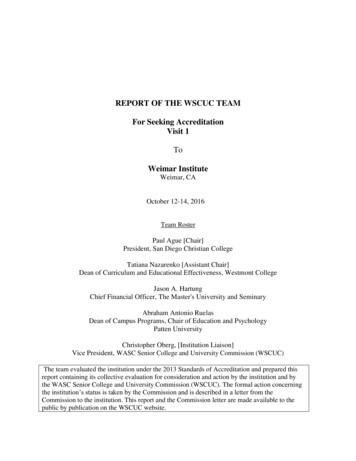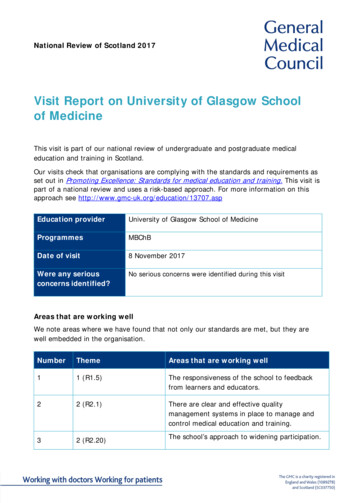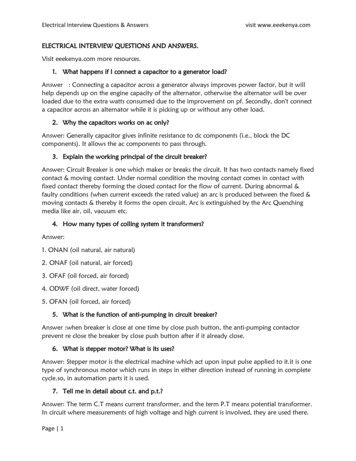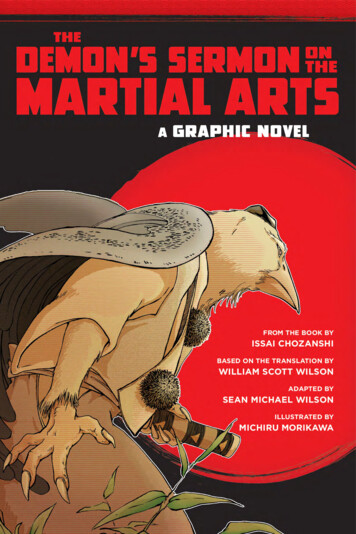
Transcription
Parul Institute of Management and ResearchReport on Industrial Visit atPanasonic Battery IndiaCompany ltd.11th August, 2014.For Semester 1 students
Industrial visit was carried out at PANASONIC BATTERIES INDIA CO Ltd.on 11th August, 2014 especially for semester one student. The mainobjective behind the visit was to make student aware about how variousactivities related to marketing, financing and human resource are carriedout in company and give them feel of managers as soon as they startthere course.I along with 35 students left for visit at 10 a.m. and took about half anhour to cover the distance. The company is located in Makarpura inVadodara city.As soon as we reached company we were guided by Mr Kapil Patel tocanteen for breakfast where a orientation of company was given by heads
established.It was great to know that company follows Japanese principal of equalityamong all the level of employees in company because of which they havesame dress code and same canteen right from higher level managerialteam to lower level workers. We found even canteen employees in samedress. Company have a policy to gather every morning for few minuteswhere they conduct prayer, narrate principles of company and are givenchance to come forward. It is the place where any new policy matters areinformed to all employees in once.Company follows principle of “People before Product” which was clearlyvisible from safety measures taken by company and other policies. Theconception of this philosophy is derived from the core objective of thecompany – ‘To Contribute to the Society’. Adhering to this philosophy, theCompany balances its business and manufacturing activities with itsimpact on the communities and people at large. Recognizing theirresponsibility towards their people, Panasonic Energy India passionatelystrives to attain progress and development of society through itsoperational activities. This core philosophy of ‘People before Product’ hasbeen imbibed and executed by all the employees from the top levelexecutives to lower level personnel across the organization.As a global company, PANASONIC is active in more than 100 countrieswith affiliated companies, associated with thousands of customers andsuppliers. Their greatest asset is their brand and its values. Their brandpromise is the heart of everything they do and everything they say. Thisis what that differentiates them and is the embodiment of the promisethey make to their customers.Their slogan ‘Ideas for Life’ is their central organizing thought. EveryPanasonic product or service is created from these ‘Ideas for Life’.
Panasonic battery India co. ltd. has the below stated objectives are givenbelow: To earn Medium Profit. To provide social facilities. Continuous improvement through reduction of Rejectionand Rework. Contribution in the development of the country.After introduction all students were divided in four groups of 15 studentsand were headed by one manager of company who helped them tounderstand how production is carried out in company and how companyreach their customer.Maximum production in company is carried out by means of machinerysubdivide in various activities like inception of raw material, mixingprocess, making jackets, covering the product and then converting it intofinished goods. Finally Finished goods are packed and are sealed whereproduction batch no is embossed for its future verification required.Company defective ratio is less than 1 percent which show the howeffective company works.At Vadodara manufacturing of R20, R40, AA, AAA and R14U batteries takeplace for differnet class of people and different use. Company produceeven separate set of production for defence also.We took almost an hour to see complete set of production which wasfollowed by questions of students. I appreciate staff member who guidedstudents with each and every question with detailed answers.It is rightly said that “See & know’ is better than ‘read & learn’. Studentshave got real feel of company’s working after this visit. They got a chanceto transfer their theoritical knowledge to practical implication. This willeven help students to understand sbject matter clearly in future also.
Me along with student would like to extend our gratitude to company forpermission and supprot they gave to make our visit a success withaccomplishment of objective and our director P. G. K. Murthy forarranging this visit for our student.ThanksProf Khyati Shah( in cordination with students )Thank You.
AREPORT ONINDUSTRIAL VISITTOCEAT TYRES PVT. LTD.HALOL PLANTON 20th AUGUST 2014BY STUDENTS OFSECTION – C (PIMR)ACCOMPANIED BYPROF. PARESH PATEL & PROF. JAYPRAKASH LAMORIAORGANIZED BYPARUL INSTITUTE OF MANAGEMENT AND RESEARCH
INTRODUCTION TO CEAT TYRE COMPANY:CEAT TYRE was established in 1958. In 1982, the RPGGroup took over CEAT Tyres of India, and in 1990, renamed thecompany CEAT Ltd.CEAT TYRE company is located in Halolnear Vadodara,Mumbai and Nasik. At Halol Plant it was foundedin 2009 and commercial production start in march 2011.Companyis mainly dealing with TYRE of Heavy vehicles likeTrucks,Buses etc.As well as for the Cars.Mainly the companyproduces two types of tyres on technology Radial technology andBias technology.For each & every new yitsResearch&Development Department.The plant in Halol isspreaded in 160acres.
FACILITY PROVIDED BY CEAT TYRE:CEAT is not resting on their laurels. Out hunger for growthcontinues with an upcoming plant and production of various PCRand TBR sizes for the Indian as well as export market. CEAT islooking at expanding its capacity from 9.4 Lacs tyres per monthto 3 million tyres.For better deliverance, they are working towards technicalcollaborations with leading tyre majors across the globe.Manufacturing Facilities:CEAT is growing at an incredible pace. 4 manufacturing plants - 3 in India and 1 in Sri Lanka10 outsourcing units for tyres, tubes and flaps3 dedicated 2-3-wheeler plants controlled by CEAT
INFORMATION REGARDED TO EMPLOYEESINCEAT TYRE: Mostly two types of Employees working with theorganization.Associates (Diploma/Engineer Freshers) andM1&Above(Managers). Providing Training,Know your machine ,On the jobtraining for freshers. Provided Medical camp,Female employment,OtherNGO,Learning the new things for the other people besidethe employees. ABOUT THE PRODUCT: Mostly two types of technologies are used.(i)Radial Technology (ii) Bias Techmology Raw material used in heticRubber(2) More than 50 chemicals are used in the product.(3)Copper wire is used for the purpose of grip. Two types of Mixer are used to mix the rawmaterails.These are Master and Final Mixer. For creation of one TYRE it passes from total 9 phase.
EXPORT&COLLABORATION OF COMPANY: CEAT makes highest export from INDIA in Truck, OTR&LCV categories. From the current scenario CEAT stood on 3rd Rank inIndia in selling TYRES.1st Rank is MRF TYRES and 2ndRank is APOLLO TYRES in India. It has collaboration with the copmpany of Srilanka withthe share holding of 51%. CHALLENGE FACED BY COMPANY& IMPROVE: High Employee Turnover Ratio – more than 40% peryear. Low employee engagement and High EmployeeAbsentism. Improved by the result of high employee enagement from44 % to 68%.
What did we do. We have visited whole plant of the industry and saw howthe TYRE is actully made by the function of each & everymachine like Mixer,Metal detector etc.
PRODUCTOIN PROCESS:RM StorageMixingTyre BuildingStock PreparationCuringFinal FinishingInspectionFG Storage
RAW MATERIAL USED Buta Ruber, Natural Ruber, Synthetic Ruber, 50 Types OfChemicals And Sulfer Base, Cooper Wire, Fabric. Carbonn Charging Machine:- In The Starting Of TheProcess, Buta Ruber, Natural Ruber & Synthetic Ruber areSended To Carbonn Charging Machine, Where All TheRuber Mixes As Per The Requirement. Master Mixer After Mixing Of Ruber, Mixer Is Sended To MasterMixer For Addition Of Different Types Of Chemicals.And It Mixes Ruber & Chemicals. Final Mixer:- Final Mixer Is Machine Where Sulfur Baseis Added. Triplex Extrude Triplex Extrude is the place where sheets of tyres areprepared. Calendar:- In Calendar Sheets are coated by Fabric &Cooper, called Bead Winding. Fabric is used for PCR &Cooper is used for TBR. AfterCoating Sheets are Checked Automatically by MetalDetector for its Perfectness. Now From here the material goes in two ways, that arefor PCR & TBR. But the ahead Process is same for both.
Cutting As per requirement, Machine cuts the Sheets. RMS In this, there are three levels, In First level 3 Or 4 Sheets(As Per Requirement ) are Combined , In Second LevelCombined Sheets are sended to B&T SIDE for shapingof Tyre and in Last Level, that is CARCASS SIDE,where Tyre Base is Created. Curving In Curving, Tyre Base is kept in MOULDING for 55Minutes, where Tyres are Curved. Inspection Each Tyre is inspecte Manually by workers. At Each Level 1 Piece Per Carton is tested in R & DDepartment. The Defective pieces of tyres & Carton of work-InProgress are cutted and sold out to smaller Businesses.
Experience from the Industrial Visit Exposure to better industrial and business practices inprogressive economies. Interaction with Guides and other person from the industryis motivating. Know business skills in a global context encouragingcultural interaction to learn better coordination betweenvarious Departments. See & know’ is better motto than ‘read & learn’. After completing the industrial visit, we have upgraded ourknowledge at a very great level. It was a good learning experience. Ineach & everydepartment, we got new ideas and new thinking which wasvery necessary for our Personal development. We have visited the entire process department. They areusing new technologies that helps us to understand about turing goods. They are strictly following quality & safety aspects. It isdesirable to review various aspects & sum up the industrialvisit.
During industrial. visit, we feel very much satisfiedbyacquiring information of various department & knowingmany new things. The industrial visit helps how to translate theory into practical. Conclusion We conclude that while going through the entire industrialvisit, the cooperation is found to be very well organized,developed & most ideal industry in every walk of itsproduction, administration & management aspects. We extend our heartiest thanks to CEAT TYRE for making20h August 2014 a day to cherish for some of the luckystudents who are honored with your humble gesture to getan opportunity to visit such an esteemed organization. We want to thank to HR Manager Krushna Vaidhya Mam ,Operation Head Mr. Hemal Patel and Mr. Mahavir Sir forguiding and sharing information about organization profileand manufacturing process at CEAT TYRES PVT. LTD.Halol Plant.
We also want to thank our director Dr. P.G.K MurthySir and faculty members, Prof. Paresh Patel and Prof.Jayprakash Lamoria for coordinating the Industrialvisit.Thank you
PARUL INSTITUTE OF MANAGEMENT AND RESEARCHINDUSTRIAL VISIT REPORTBARODA MOULDS AND DIESBY – MBA students2014
Contents1. Introduction2. Organizational structure3. Products4. Process4.1 raw materials process4.2 Die working4.3 Finishing4.4 Testing4.5 Packing5. Achievement6. Conclusion
1. IntroductionBARODA MOULDS AND DIES48, 30, 31 &32, GIDC, Waghodia,Dist. Baroda-391760, GujaratPh.: 91-02668-262148bmd@epoxyhouse.comUnder the corporate umbrella of “Epoxy House”, the group is primarilyengaged in manufacturing of Epoxy resin cast components addressing theswitchgear and transformer industry in general.1972 instituted the flag ship company M/s. Baroda bushing & insulators forproduction of various types of Epoxy moulded components.1997 Instituted kaizen switchgear products, A 100% Export Oriented Unit.The company is has a global market share in Abu Dhabi, Australia, Bangladesh,Belgium, China, Czech Republic, Dubai, Egypt, France, Germany, Italy, Kuwait,Lithuania, Malaysia, Mexico, Nepal, New Zealand, Poland, Portugal, SaudiArabia, Sweden, Taiwan, Thailand, The Netherlands, Ukraine, UK and USA.2003 commenced production and supply of dry type CT/VT’s fromCycloaliphatic resin system for outdoor application.
2. Organizational structureG.MMilanbhaiProprietorD.P. PatelMr. Kirit PatelPurchase managerYatin.H.patelC.E.OArvindbhai PatelProduct EngineerVaibhav Patel
3. ProductsEpoxy resin cast insulators
4. Process4.1 raw materials processThe raw material is being made by the mixer of resin, plastic chocolate coloredand hardener. The tank shown under mixes the material for some time andgoes for the next process.4.2 Die workingAfter the mixing of raw material the said mixer is being sent for dying work.The Die machines convert the mixer in a product. This machines takes around12 hours to make 20 products.
4.3 FinishingAfter the process of die machines the final finished products comes out. Thefinished product is not yet ready to sell the further process is being done onthe product.
4.4 TestingThere are so many types of testing of a product. Some are discussed as below.1.2.3.4.5.High Voltage testing (HV testing)Partial Discharge testing (PD testing)Insulation Resistance testing (IR testing)Capacitance testingLow live indication testing
6. Voltage indication testing7. Mili voldrop testing8. BDV testing4.5 PackingThe last process is of packing process. The products which are ready to sell arepacked in the boxes with high securities. The packing process is being the lastprocess of the organization.5. AchievementsAwarded Export Excellence certificate for Electrical controls and systemsfor achieving highest export for the year 1997-98 by Engineering ExportPromotion Council, a
Report on Industrial Visit at Panasonic Battery India Company ltd. 11th August, 2014. For Semester 1 students . Industrial visit was carried out at PANASONIC BATTERIES INDIA CO Ltd. on 11th August, 2014 especially for semester one student. The main objective behind the visit was to make student aware about how various activities related to marketing, financing and human resource are carried .











